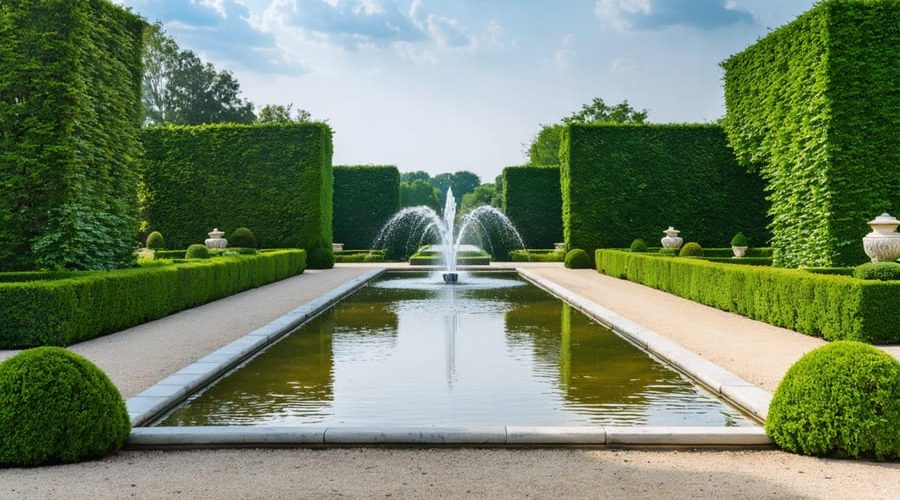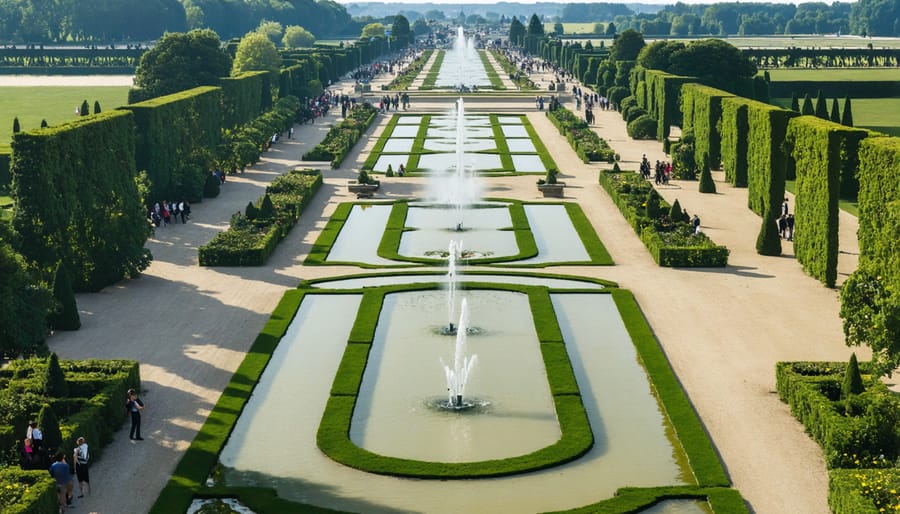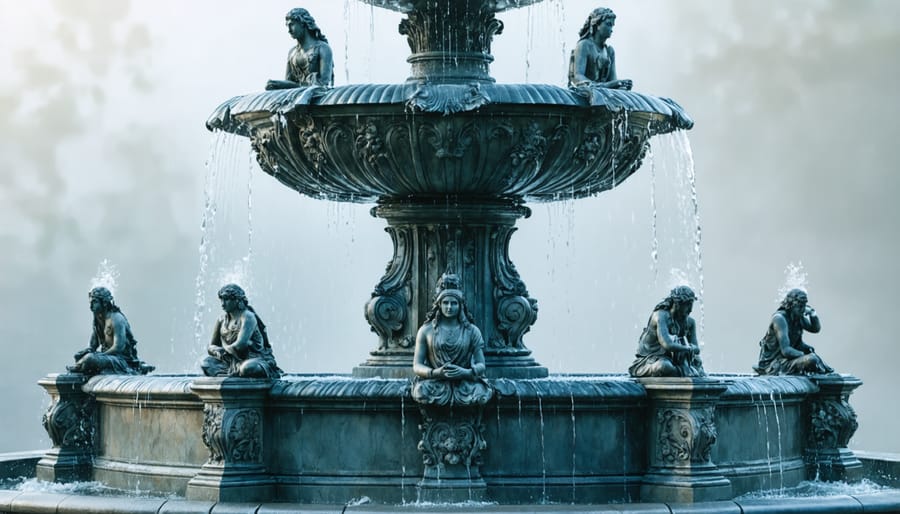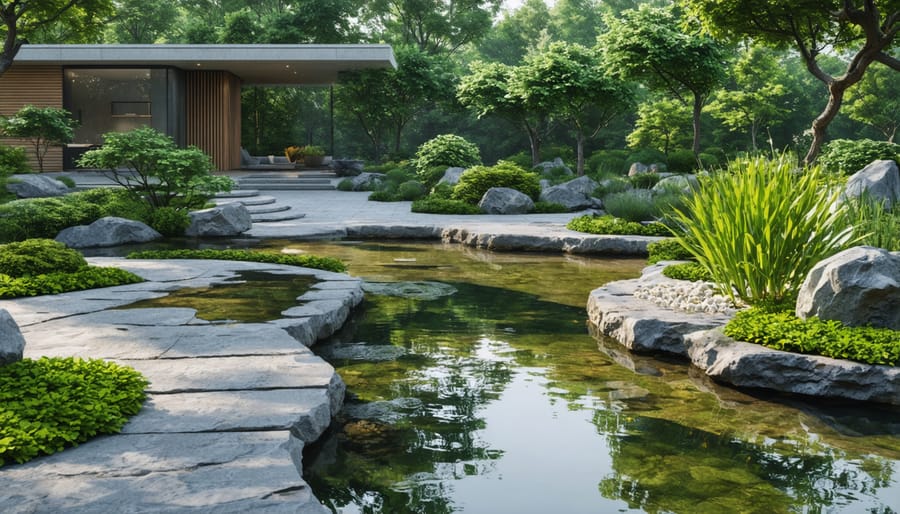
How 18th Century Water Gardens Shaped Modern Pond Design (And Why It Matters)
Step into the grand romance of 18th-century gardens, where formal elegance meets nature’s wild beauty in ways that have shaped modern pond design and landscape architecture. These magnificent spaces weren’t just gardens – they were outdoor theaters where aristocrats showcased their wealth, taste, and mastery over nature.
Picture perfectly symmetrical pathways leading to elaborate fountains, meticulously trimmed hedges creating living walls, and water features that seemed to defy gravity. From Versailles to Stourhead, 18th-century gardens transformed European landscapes into carefully orchestrated displays of human ingenuity and artistic vision.
What made these gardens truly revolutionary was their clever use of perspective, the integration of classical architecture with natural elements, and the creation of carefully planned “surprise” views that delighted visitors at every turn. These design principles weren’t just about showing off – they represented a fundamental shift in how humans viewed their relationship with nature, moving from medieval fear to Enlightenment-era control and appreciation.
Today’s garden enthusiasts can still learn from these masterpieces of landscape design, whether working with a sprawling estate or a modest backyard. The 18th century’s lessons about proportion, sight lines, and the dramatic use of water features remain as relevant now as they were 300 years ago.
The Golden Age of Water Gardens
French Formal Gardens
The grand water features of French formal gardens, particularly those at Versailles, revolutionized garden design with their stunning blend of historical water garden elements and artistic innovation. These gardens showcased massive fountains, reflective pools, and cascading waterfalls that created a sense of drama and power. The iconic Grand Canal at Versailles, stretching nearly a mile long, demonstrated how water could be used to create stunning visual perspectives and mirror-like effects.
What made these gardens truly special was their precise geometric layout and the way water features were integrated into the overall design. Fountains weren’t just decorative elements; they served as focal points that guided visitors through carefully planned garden paths. The use of tiered fountains and water staircases created dynamic movement and soothing sounds throughout the space.
Today, you can incorporate these classic French garden principles into your own water feature designs. Consider adding a small reflecting pool, symmetrical fountain placement, or even a modest cascade to capture that timeless elegance on any scale.

English Landscape Movement
The English Landscape Movement brought a revolutionary change to garden design, championing natural-looking spaces over formal layouts. Led by Lancelot “Capability” Brown in the mid-1700s, this style transformed countless estates with gracefully curved lakes, rolling lawns, and strategically placed tree clusters. Brown earned his nickname by famously telling clients their properties had “great capabilities” for improvement.
Unlike the rigid French gardens, these landscapes flowed naturally, featuring winding paths, gentle slopes, and water features that looked like they’d always been there. Brown’s signature touch included carefully shaped lakes with curved edges that disappeared behind hills or trees, creating an illusion of endless water. He removed formal gardens and straight lines, replacing them with sweeping vistas and scattered tree groupings.
This natural style caught on quickly among English aristocrats, who wanted their estates to look effortlessly beautiful. Brown’s influence spread beyond Britain, inspiring garden designers worldwide and shaping how we think about landscape design even today. His principles of working with nature rather than against it remain relevant for modern gardeners.
Key Design Elements That Stand the Test of Time

Water Features and Fountains
Water features and fountains were the crown jewels of 18th-century gardens, serving both as stunning focal points and symbols of wealth and sophistication. Classical designs often featured tiered fountains with elaborate sculptures, typically depicting mythological figures like Neptune or Venus. These grand water displays were carefully engineered to create various effects, from gentle cascades to dramatic water jets.
Popular styles included the parterre fountain, which complemented formal geometric gardens, and the cascade fountain, often built into hillsides to create a natural-looking water flow. Many fountains incorporated multiple water effects, with central jets surrounded by smaller spouts or water curtains, all working together to create a mesmerizing display.
Today, you can recreate these classical elements on a smaller scale. Modern pumps and filtration systems make it easier than ever to maintain beautiful water features inspired by 18th-century designs. Consider incorporating elements like carved stone basins, classical statuary, or tiered bowls. Even a simple wall fountain with period-appropriate details can capture the essence of these historical gardens.
For authentic touches, look for materials like limestone or marble, and consider adding period-appropriate details such as shell motifs or geometric patterns. Remember that symmetry and proportion were key elements in 18th-century design, so maintain balanced dimensions in your water feature planning.
Plant Selection and Placement
Many of the plants favored in 18th-century water gardens remain popular choices today, offering both historical authenticity and proven performance. Water lilies were particularly cherished during this period, with white varieties symbolizing purity and pink ones representing love and passion. These aquatic beauties continue to grace modern ponds, providing the same elegant floating displays that captivated garden visitors centuries ago.
Iris pseudacorus, or yellow flag iris, was another 18th-century favorite that’s still widely used. These striking yellow blooms naturally occurred along waterways and were carefully cultivated in formal water gardens. Rushes and sedges were strategically placed to create natural-looking transitions between water and land, a technique that remains effective today.
Marginal plants like flowering rush and sweet flag were commonly used to soften pond edges, while submerged oxygenating plants helped maintain water clarity. Many gardeners also incorporated decorative grasses and ferns near water features, creating the lush, layered look characteristic of the period.
To recreate an authentic 18th-century feel, consider placing taller plants like cattails and bulrushes at the back of water features, with shorter specimens gradually stepping down toward the water’s edge. This traditional approach to plant placement creates depth and visual interest while maintaining historical accuracy.
Symmetry and Natural Flow
In 18th-century gardens, symmetry wasn’t just about creating mirror images – it was an art form that celebrated nature’s harmony. Garden designers of this era believed that balanced layouts created a sense of peace and order, much like the formal French gardens that influenced them. Water features played a central role in achieving this balance, with reflecting pools often placed along central axes to create stunning mirror effects.
These gardens typically featured matching pathways on either side of water features, with identical plantings and decorative elements carefully positioned to create perfect symmetry. Fountains were often placed at key intersections, serving as focal points that drew the eye through the garden’s carefully planned vistas.
Natural flow was equally important, with water features designed to mimic nature’s patterns. Streams and cascades were engineered to appear as if they’d always been there, despite being entirely man-made. This blend of formal symmetry and natural movement created spaces that felt both grand and inviting – a design principle that still influences modern water gardens today.
The secret to their success lay in careful planning, with designers using geometric principles to create spaces that felt both ordered and organic. These gardens proved that when symmetry and natural flow work together, the result is truly timeless.

Creating Your Own Historical-Inspired Water Garden
Scale and Proportion
While 18th-century gardens were famously grand in scale, you don’t need a sprawling estate to capture their elegant essence and transform your backyard paradise. The key is understanding proportion and adapting classical design principles to suit your space.
Start by dividing your garden into distinct zones, much like the formal gardens of the period. For a small yard, consider a 3:2:1 ratio – the largest area for your main feature (like a pond or lawn), a medium-sized space for pathways or seating, and smaller areas for decorative elements.
When incorporating water features, scale them according to your available space. A grand cascade can become an intimate wall fountain, while expansive reflecting pools can be interpreted as compact geometric ponds. Remember that even the smallest water feature can create a striking focal point when properly proportioned.
Use plants strategically to create the illusion of space. Tall, architectural plants at the back of borders draw the eye upward, while low-growing specimens in the foreground extend perceived depth. Consider dwarf varieties of period-appropriate plants to maintain historical accuracy without overwhelming your space.
For pathways and borders, maintain proportional widths – generally, main paths should be wide enough for two people to walk side by side, while secondary paths can be narrower. This creates a comfortable flow while maximizing garden space.
Traditional Materials in Modern Settings
Creating an authentic 18th-century garden feel doesn’t mean you have to break the bank or source rare materials. Many traditional materials can be substituted with modern alternatives while maintaining historical accuracy. For pathways and borders, crushed limestone or gravel closely matches the appearance of period materials and provides excellent drainage. Natural stone remains a timeless choice, with slate and sandstone being particularly authentic options for edging and steps.
For ornamental features, cast stone or high-quality concrete can replicate the look of carved limestone at a fraction of the cost. Modern composite materials designed to mimic lead or bronze work well for urns and statuary, offering better durability and weather resistance than their historical counterparts.
When it comes to water features, modern pond liners can be disguised with period-appropriate stone facing. Traditional clay-lined ponds can be recreated using modern waterproof concrete, which offers superior longevity. For garden structures, treated timber can replace expensive hardwoods while maintaining the aesthetic when properly finished.
Consider incorporating reclaimed materials where possible – salvaged brick, stone, or architectural elements add authentic charm and character. Remember that many 18th-century gardens evolved over time, so mixing traditional and contemporary materials thoughtfully can create a garden that feels both historic and practical for modern maintenance.
Maintaining Historical Character
Modern Solutions for Period Features
Today’s garden enthusiasts can capture the magic of 18th-century garden features while embracing modern convenience and sustainability. Instead of traditional lead pipes, we now use durable PVC and copper piping systems that are both safer and more efficient for water circulation. Solar-powered pumps offer an eco-friendly alternative to manual water wheels, maintaining consistent water flow in fountains and cascades while reducing energy costs.
For those seeking authentic-looking stone features, modern glass-fiber reinforced concrete (GFRC) provides the appearance of carved limestone but weighs less and requires minimal maintenance. These materials resist weathering better than traditional stone while maintaining historical accuracy in appearance.
LED lighting systems can recreate the romantic glow of oil lamps and torches, with programmable options to mimic natural flame patterns. Modern waterproofing compounds and pool liners allow for reliable water containment without the leakage issues that plagued historical gardens.
Even plant maintenance has evolved. Automated irrigation systems can be disguised within period-appropriate features, while modern water treatment methods keep ornamental ponds clear without disrupting their historical appearance. Time-release fertilizers hidden in decorative urns help maintain lush period-appropriate plantings with minimal visible modern interference.
The key is selecting solutions that preserve the garden’s historical integrity while incorporating contemporary innovations discreetly beneath the surface.
Seasonal Care Tips
Maintaining an 18th-century style garden requires attention to seasonal changes, just as historical gardeners did. In spring, focus on clearing winter debris from water features and checking pond linings for damage from frost. March is ideal for dividing and replanting water lilies, while April calls for introducing new aquatic plants.
Summer maintenance centers on controlling algae growth, a challenge familiar to historical gardeners. Keep fountain mechanisms clean and ensure water levels remain consistent, especially during hot spells. Traditional gardens often used floating plants like water lettuce to provide natural shade and reduce algae.
Fall preparation is crucial for protecting delicate features. Remove fallen leaves promptly to prevent water staining on ornamental stonework and reduce organic matter in ponds. Consider installing protective netting over water features, a modern solution to a historical problem.
Winter care focuses on preventing damage to stone fountains and statuary. In regions with harsh winters, drain and cover fountains to prevent freeze damage. Historical gardens often employed straw coverings for protection; today, we can use specialized fountain covers while maintaining period aesthetics.
Year-round, maintain proper water circulation in ponds and fountains to prevent stagnation, just as 18th-century gardeners did with manually operated systems. Regular pruning of surrounding ornamental plants helps preserve the garden’s formal appearance, essential to period authenticity.
The timeless appeal of 18th-century water garden design continues to inspire and delight modern gardening enthusiasts. These classical gardens perfectly balanced natural beauty with human artistry, creating spaces that served both as peaceful retreats and impressive displays of architectural prowess. Today’s homeowners can still capture this magic in their own outdoor spaces, whether working with a small courtyard fountain or a grand reflecting pool.
What makes these designs so enduring is their fundamental understanding of human nature’s connection to water. The soothing sounds of cascading fountains, the peaceful reflection of sky in still pools, and the gentle movement of water through channels all speak to something deep within us – just as they did centuries ago.
The principles of symmetry, proportion, and careful placement that guided 18th-century garden designers remain relevant for contemporary landscaping. By incorporating these elements thoughtfully, modern gardeners can create spaces that feel both historically inspired and perfectly suited to today’s lifestyle needs.
Perhaps most importantly, these gardens remind us that outdoor spaces can be more than just pleasant additions to our homes – they can be transformative environments that inspire contemplation, encourage social gathering, and connect us with the natural world. As we face increasingly urban and digital lives, the wisdom of 18th-century garden design offers us a template for creating outdoor sanctuaries that refresh both body and spirit.
